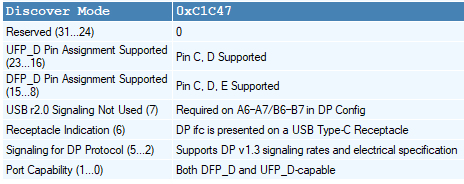SLLA565 September 2021 TUSB1044
6.3 Example of I2C Configuration Upon Cable-Orientation Event and DP Configuration Event
The TPS65994 takes over the PD communication to identify whether a USB, USB+DP, four-lane DP device is connected to alert the SOC and also to control the redriver, retimer, or MUX to the corresponding mode based on CC hand-shake results.
TUSB1044 control is based on the configuration to bit[2:0] of 0x0A. Consider a cable attach event with orientation (Attach_UU, Attach_UD, or cable orientation event) to trigger a USB3 configuration and MUX control after PD controller recognized the connection of external device.

Figure 6-2 Example of USB3 Normal Orientation Configuration to TUSB1044
If the host (as DFP_D) and device (as UFP_D) establish the DP alternate mode connection, the host PD (usually with DFP_D pin C, D, E support based on notebook system design) will acknowledge the device supported pin assignment and preference on multifunction through the ACK message of the device-side PD controller. The PD controller finally selects one of the pin assignments and control or alert the TUSB1044 or SOC accordingly.

Figure 6-3 Example of Discover Mode ACK PD Message (Pin C, D as UFP_D Both Supported)
For a DP connection, there are two trigger events with DP pin A, C, or E, and pin B, D, or F depending on the DP alternate mode negotiation with the connected device.

Figure 6-4 Example of a DP Pin A, C, or E Configuration to TUSB1044
Table 6-2 summarizes an example of control data and trigger events respectively.
| Connected Device, Flip | Data | Trigger Event |
|---|---|---|
| Unconnected | 0x100A | PoR, Detach |
| USB | 0x110A | cable_oriented (cable_attach_UU) |
| USB_Flip | 0x150A | cable_oriented (cable_attach_UD) |
| Pin B, D, F (for example, USB+DP) | 0x130A | DP Config BDF_UU |
| Pin B, D, F_Flip | 0x170A | DP Config BDF_UD |
| Pin A, C, E (for example, 4-lane DP) | 0x120A | DP Config ACE_UU |
| Pin A, C, E_Flip | 0x160A | DP Config ACE_UD |
Considering the direction of data transmission, UEQ of the TUSB1044 influences the USB TX and DP test, while DEQ influences only the USB RX compliance test. If in a certain case USB TX and DP compliance require different EQ settings, use the USB3, DP select event as the trigger event to initiate a separate configuration to the EQs.
The PD Alternate Mode: DisplayPort application note provides a detailed introduction of DP alternate mode.